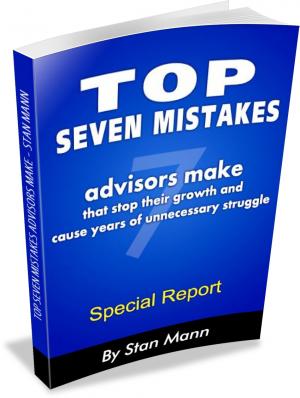Six Steps Toward Successful Follow-Up Calls
 You know follow-up calls to prospects are important – essential really – but you may be uncertain of how to go about them and what to say. Nothing is more demotivating than not knowing how to do something. It leads to procrastination and anxiety.
You know follow-up calls to prospects are important – essential really – but you may be uncertain of how to go about them and what to say. Nothing is more demotivating than not knowing how to do something. It leads to procrastination and anxiety.
Believe me, I know. I used to stare at my 500 pound telephone, knowing I should make those calls, but fearful I would screw up. All that changed when my coach taught me the six steps for successful follow-up calls.
It goes like this.
Imagine you have a referral from your friend Steve. Steve's told you that you might be able to help George with his retirement plans. Steve was unclear as to exactly what George wanted. Steve just knew George was complaining about trying to figure out his plans for retirement.
You try to have Steve introduce you, but he begs off and says, "just tell him I thought maybe you could help him." Sound familiar?
So George might be a real candidate for a services, or he might not. You wonder what's the best way to turn George into a hot lead. You're wondering what to say when you call to move the conversation forward.
Here are six steps proven to work:
- Do an attitude check.
- Prepare; do your homework and research your prospect.
- Reach out to connect.
- Follow-up with an email.
- Conduct your first conversation.
- Have a call to action.
1. Do an attitude check.
If you've been reading my blog and reports you know I strongly believe you have to have the right mindset for any technique to work.
Make your calls with this mindset
- I have a lot to offer the right candidate (review all the people you have a worked with and how they benefited).
- I have no idea if I can help them until I know more about his goals and challenges and available opportunities.
- I need to be interested in him more than I am in explaining my services. Listen 80% of the time and talk 20%.
- I'm simply exploring if there is a need. I'll offer consultation only if he has a need I can fulfill.
- I'm talking to a human being like myself with desires and challenges and wants to be heard.
Now you're set to go. Your attitude will color everything you say and how you come across.
2. Get ready for your call.
Learn as much about your potential client as you can – the more the better. Talk to Steve and learn what he knows about George. What is his business or occupation? What are his hobbies, education and awards? Who are his wife and kids? What clubs or organizations does he belong to? Then Google him.
Knowing about him helps you feel more connected and more comfortable making that call. Look for things you have in common so you can establish deeper rapport.
3. Reach out on your first call.
You're probably used to finding people very busy and hard-to-reach. Prepare a voicemail script. Practice it until it's in your bones. Have a follow-up email ready.
Your voicemail message may be:
Hi George,
Steve Brown recommended I give you a call. I work with (insert your core marketing message here). [This core message is essential. You can read more about crafting effective marketing messages on this website.]
I don't know whether I can help you or not, but I'd be happy to have a brief talk. You can reach me at 555-9216. I'll also email you my online calendar where you can choose a time that's good for you if you'd like to talk.
I look forward to seeing if I can help you with your retirement plans.
Note: you must have a compelling core marketing message. It's not only important for these calls; it is the heart of your marketing
4. Follow-up with an email message.
Here's a sample of a follow-up email message:
Hi George,
I left you a voicemail about Steve Brown recommending that I contact you and set up a time for a brief talk. I work with (name of his company) executives like yourself who want to make the most of their retirement options. I don't know if I can help you or not, but I'd enjoy learning more about you.
You can learn more about me by going to my website: website.com
I also have a report Steve found valuable. You might find it worthwhile too. It's called, "How to Plan for the Retirement You Really Want." Here's the link:
website.com/article.
The best way to arrange our talk and avoid phone tag is to choose a time you like from my online calendar timetrade.com WXP
If I don't hear from you in a few days, I'll reach out again. Steve says your very busy
Best wishes,
Bill Smith
Retirement Solutions, LLC
To make the system work, you need to be persistent in a friendly manner. It may take five or six attempts to connect.
5. Conduct your first conversation.
During your first call, talk about him, draw upon your research and start by mentioning things you have in common. Complement him on any awards he may have received, his website and LinkedIn profile. You're there to talk about him and to learn about his business so you can determine if he has any need for your services. If you find no opportunity," close gracefully and thank him for his time.
6. Have a call to action.
If during your conversation you see where you might help your potential client, say:
"There's a possibility I could help you out with (mentioned the challenges and concerns he shared with you). " Tell a story about when you helped somebody else with similar issues. Then give your marketing message. Say something like: "I help executives at (his company) choose their retirement options wisely and reach their retirement goals."
"I offer a free financial review session where we'll explore your retirement needs in more depth. Would you like to take advantage of that?"
If you follow all the steps up to this point, establish rapport, were truly interested in him and sounded credible, he very likely will say yes. (I have a 89% success rate.)
Wishing you a rich and rewarding business and life
Stan Mann




 Tell a Friend
Tell a Friend Book a Meeting
Book a Meeting Contact Us
Contact Us